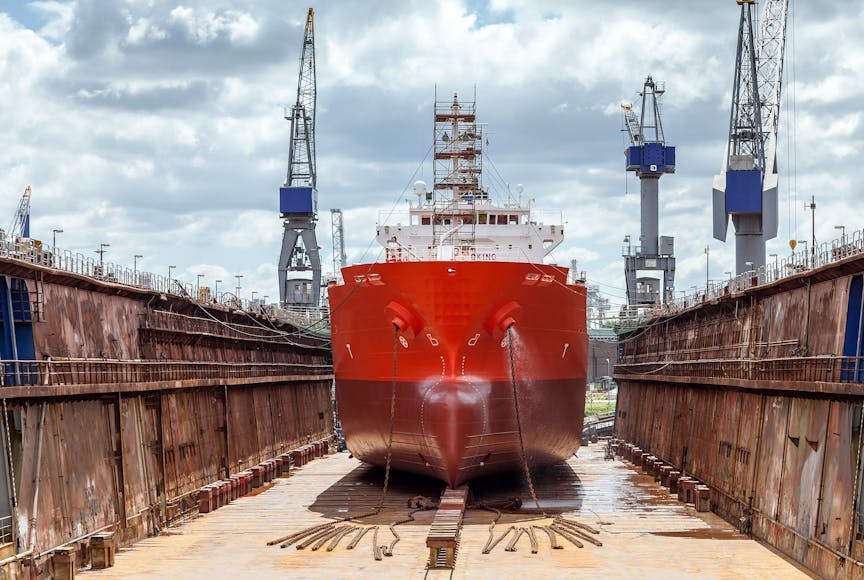Dry Docking

For the shipowner, dry docking is costly and carries a high level of risk; therefore, effective planning and management are vital to maintain safety, and minimise costs and time out of service.
Contractual liability
When damage occurs to a vessel during maintenance and repair work in a shipyard, responsibility and contractual issues can be a complicated. Who is responsible for the damage caused and who is obligated to pay for the repairs?
It is important that in the contract with the shipyard the shipowner ensures a clear allocation of responsibility for damages caused to the vessel during repair/maintenance work.
The yards normally base their contractual obligations on general terms and conditions. Ordinarily the yard and its subcontractors limit their liability in the contract and the yard’s liability to pay for a loss or damage is limited to the agreed maximum amount.
Before signing a contract, the shipowner should pay attention to the contractual terms and conditions to achieve an appropriate allocation of liability and compensation between the parties in the contract: especially the liability clause and the insurance.
Important pointers to note when a contract is negotiated and agreed with the shipyard:
- The contractor’s limitation of liability shall be in reasonable proportion to the value of the vessel and the scope of work.
- The contractor shall provide evidence of a ship repairer’s liability insurance covering at least the agreed limitation of liability.
- The allocation of responsibilities between the contractor and the shipowner must be agreed.
- All parties involved shall have a common understanding of what is agreed in the contract.
- The Insurers of the vessel shall be informed.
Dry docking – general best practices
Prior to dry docking:
- Submit the vessel’s docking plan to the shipyard for correct block arrangement and proper fendering
- Agree on yard specification (e.g., all the work to be done by the yard or their subcontractors)
- Check and ensure access to the yard for possible sub-contractors ordered by owner
- Check and ensure storage facilities at the yard for possible owners’ deliveries of spare parts or equipment
- Ensure that the liability, delayed delivery, and insurance clauses are clearly stated and mutually agreed and understood
- Supplier and service personnel coordination
- Prepare for possible crew change during dry-docking and access for crew to yard
Vessel preparation:
- Drafts (min/max) arrival condition and prepare stability calculation. In most cases vessel should float on even keel.
- Record tank status
- Gas free fuel tanks that have planned works
- Cargo tanks and cargo piping gas free including gas free certificate
- Sludge, sewage, and other substances to be discharged
- Yard safety and regulation briefing
Vessel arrival to yard:
- Waiting at anchorage or berthed at yard
- Mooring at yard prior to dry-docking
- Safe access to ship during waiting
- Arrange possible need for tug assistance
Vessel docking in:
- Arrange possible need for tug assistance
- Propeller shaft deflection and engine measurements
- Note the time when the vessel “on-blocks”
Dry docking:
- Firefighting water connection
- Shore power connection
- Yard safety briefing and communication plan
- Dry docking survey – bottom inspection – block alignment
- Two independent gangways for safe access to the vessel
- Fire and enclosed space entry watches and work permits to be agreed with the yard
- Craneage to be agreed with the yard
- Work site lights and ventilation to be agreed with the yard
- Equipment and system protection for welding, blasting, and washing
- Disablements to be agreed with the yard
- Waste and scrap disposal to be agreed with the yard
Pre-floating (flooding above high sea chest, but vessel on blocks):
- Bottom plugs, manhole covers in place and inspected
- All sea-water valves and necessary piping in place and checked
- Sea chests and propeller shaft seals inspected
- Ballast status and stability calculation
- Inspect and verify hull integrity
- Disconnect shore power
- Disconnect firefighting hoses from yard
Floating – departure:
- Note the time “off-blocks”
- Propeller shaft deflection and engine measurements
- Enable all disabled equipment
- Arrange for possible tug assistance for floating and departure
- Verify the need and scope of possible sea-trials
- Check availability and need for waiting berth after floating
- Check mooring arrangements at waiting berth
- Arrange and agree shore power availability and connection at waiting berth
Disclaimer
This list is only a general recommendation and information on main activities. It is not exhaustive. Authorities and classification society’s rules and regulations must be followed at all times. Alandia can not accept any responsibility in respect of any loss or damage of any kind whatsoever which may arise from sole reliance on this information.